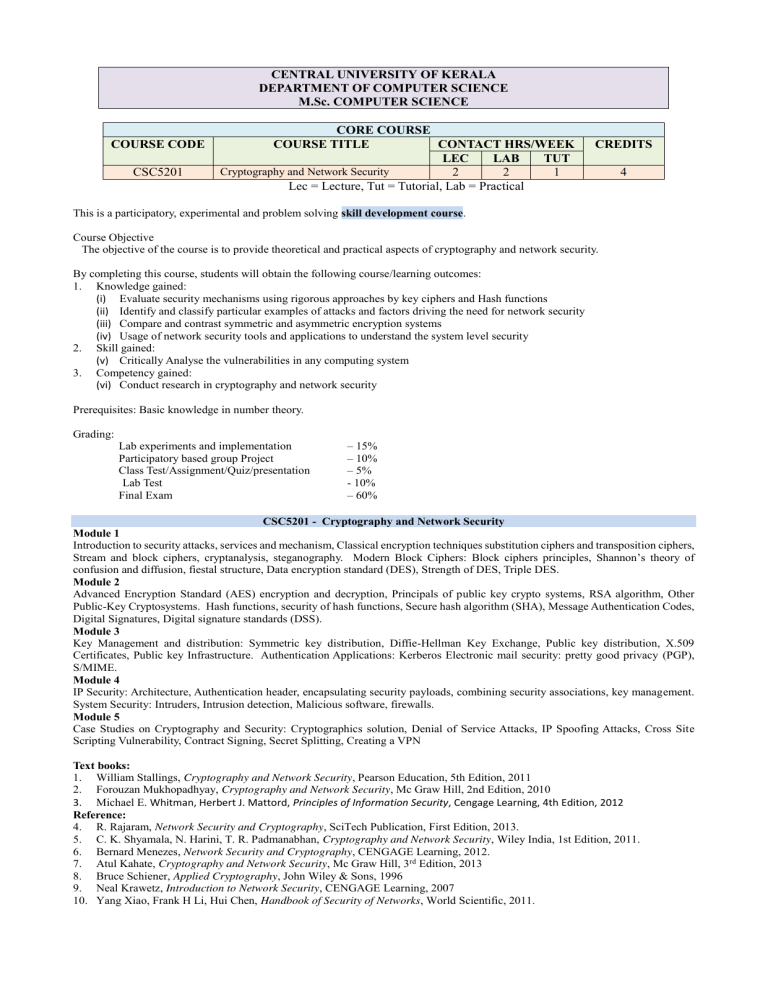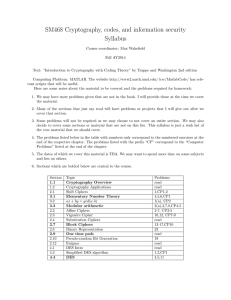
CENTRAL UNIVERSITY OF KERALA DEPARTMENT OF COMPUTER SCIENCE M.Sc. COMPUTER SCIENCE COURSE CODE CSC5201 CORE COURSE COURSE TITLE CONTACT HRS/WEEK LEC LAB TUT Cryptography and Network Security 2 2 1 Lec = Lecture, Tut = Tutorial, Lab = Practical CREDITS 4 This is a participatory, experimental and problem solving skill development course. Course Objective The objective of the course is to provide theoretical and practical aspects of cryptography and network security. By completing this course, students will obtain the following course/learning outcomes: 1. Knowledge gained: (i) Evaluate security mechanisms using rigorous approaches by key ciphers and Hash functions (ii) Identify and classify particular examples of attacks and factors driving the need for network security (iii) Compare and contrast symmetric and asymmetric encryption systems (iv) Usage of network security tools and applications to understand the system level security 2. Skill gained: (v) Critically Analyse the vulnerabilities in any computing system 3. Competency gained: (vi) Conduct research in cryptography and network security Prerequisites: Basic knowledge in number theory. Grading: Lab experiments and implementation Participatory based group Project Class Test/Assignment/Quiz/presentation Lab Test Final Exam – 15% – 10% – 5% - 10% – 60% CSC5201 - Cryptography and Network Security Module 1 Introduction to security attacks, services and mechanism, Classical encryption techniques substitution ciphers and transposition ciphers, Stream and block ciphers, cryptanalysis, steganography. Modern Block Ciphers: Block ciphers principles, Shannon’s theory of confusion and diffusion, fiestal structure, Data encryption standard (DES), Strength of DES, Triple DES. Module 2 Advanced Encryption Standard (AES) encryption and decryption, Principals of public key crypto systems, RSA algorithm, Other Public-Key Cryptosystems. Hash functions, security of hash functions, Secure hash algorithm (SHA), Message Authentication Codes, Digital Signatures, Digital signature standards (DSS). Module 3 Key Management and distribution: Symmetric key distribution, Diffie-Hellman Key Exchange, Public key distribution, X.509 Certificates, Public key Infrastructure. Authentication Applications: Kerberos Electronic mail security: pretty good privacy (PGP), S/MIME. Module 4 IP Security: Architecture, Authentication header, encapsulating security payloads, combining security associations, key management. System Security: Intruders, Intrusion detection, Malicious software, firewalls. Module 5 Case Studies on Cryptography and Security: Cryptographics solution, Denial of Service Attacks, IP Spoofing Attacks, Cross Site Scripting Vulnerability, Contract Signing, Secret Splitting, Creating a VPN Text books: 1. William Stallings, Cryptography and Network Security, Pearson Education, 5th Edition, 2011 2. Forouzan Mukhopadhyay, Cryptography and Network Security, Mc Graw Hill, 2nd Edition, 2010 3. Michael E. Whitman, Herbert J. Mattord, Principles of Information Security, Cengage Learning, 4th Edition, 2012 Reference: 4. R. Rajaram, Network Security and Cryptography, SciTech Publication, First Edition, 2013. 5. C. K. Shyamala, N. Harini, T. R. Padmanabhan, Cryptography and Network Security, Wiley India, 1st Edition, 2011. 6. Bernard Menezes, Network Security and Cryptography, CENGAGE Learning, 2012. 7. Atul Kahate, Cryptography and Network Security, Mc Graw Hill, 3rd Edition, 2013 8. Bruce Schiener, Applied Cryptography, John Wiley & Sons, 1996 9. Neal Krawetz, Introduction to Network Security, CENGAGE Learning, 2007 10. Yang Xiao, Frank H Li, Hui Chen, Handbook of Security of Networks, World Scientific, 2011.


